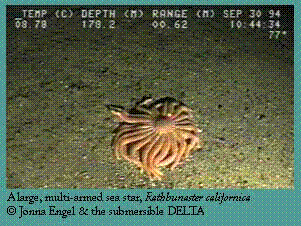Deeper Bottom Habitats
II. Faunal Assemblages on the Continental Shelf
(40 - 600 m depth)
Very few studies of the benthic faunal assemblages have been conducted beyond the depths accessible by scuba, and most of those are limited to the shallower depths. Perhaps the most thorough quantitative study was that of Hodgson and Nybakken (1973) which reported on a two year study at 10 stations covering a depth range of 16 to 60 m north of the Monterey Canyon. A similar study at several stations in the same depth range south of Monterey Canyon was initiated by Dr. Welton Lee of Hopkins Marine Station before the Hodgson and Nybakken study, but it was apparently not summarized or published. A 60 m station off the Pajaro River established in the Hodgson & Nybakken study has been sampled sporadically during the last 10 years, and was the focus of an undergraduate research course in 1988 that produced several studies of certain organisms (pers. unpublished reports). The only other quantitative research in this depth range identified described fauna between 50 and 600 m on the continental shelf off San Francisco (i.e. near, but not within the MBNMS northern boundary) as part of a study preceding installation of an ocean sewer outfall in 1983 (Nybakken et al. 1984). Perhaps the most useful qualitative studies are the video explorations done by MBARI in the uppermost reaches of the Soquel canyon at depths of around 200 m. Though other qualitative (and perhaps quantitative) studies undoubtedly exist, they are unknown to the author.
Most of the sampling between approximately 40-600 m depth has been conducted either with a Smith-McIntyre grab or interfacial trawl, and screened on 1 mm mesh. Therefore, most of the organisms documented are relatively small, slow-moving infaunal invertebrates. There are few data on the megafaunal epifaunal invertebrates except as incidental observations, captures in otter trawls, and/or donations from fishermen.
In both the northern Monterey Bay study (Hodgson and Nybakken 1973) and the San Francisco study (Nybakken et al. 1984), infauna was dominated by polychaete worms that usually comprised 50% or more of the total number of individuals at each station. Polychaetes were also most abundant in terms of number of species captured. Next in abundance were the bivalve and gastropod molluscs, comprising 20-25% of the individuals counted, followed closely by the crustaceans (13 to 25% of individuals). Except for brittlestars, echinoderms tend to be of negligible abundance. These abundances did not change significantly from season to season, except in the San Francisco study where seasonal densities of the infauna varied markedly at the 600 meter station and less drastically at the 50 m station. The total number of infaunal invertebrate species reported in the northern Monterey Bay study was 383 while in the San Francisco study the total species number was 309. The amount of overlap in these figures has not been ascertained, but is probably significant. Due to lack of data, no information exists about yearly or longer-term changes in faunal assemblages.
Observations at the head of Soquel Canyon in about 200 m depth (by the Monterey Bay Aquarium Research Institute's remotely operated vehicle ROV Ventana indicate that the most abundant large epifaunal invertebrates are crinoids and basket stars. Occasional otter trawls by Moss Landing Marine Laboratories classes (pers. obs.) in northern Monterey Bay at depths of 60-100 m indicate that sea pens, notaspidean opisthobranchs, the octopus Octopus rubescens, the benthic squid Rossia and the sea star Luidia are the common large epifaunal organisms. At certain seasons of the year commercial fishermen bottom trawling on the MBNMS continental shelf also occasionally bring in specimens of the giant squid Moroteuthis robustus.
There are no published compilations of the total number of invertebrate species living in the depth range of 40-200 m throughout the MBNMS, but there are a few compilations for all of Monterey Bay that may give some clues as to the richness of the fauna. For example, Smith and Gordon (1948) list 725 species of Mollusca, Weymouth (1910) lists 52 species of brachyuran crabs, and May (1924) lists 24 species of brittlestars.
 The species assemblages in the depths of 40-200 m seem to be more similar
to assemblages in shallower depths, 15-35 m, than to those in deeper waters.
However, this observation is based primarily on the comparisons from the
San Francisco study, and similar comparisons have not been made for northern
Monterey Bay due to lack of any comparable data from deeper areas. In general,
polychaete species were found to be more widely distributed by depth than
molluscs or crustaceans.
The species assemblages in the depths of 40-200 m seem to be more similar
to assemblages in shallower depths, 15-35 m, than to those in deeper waters.
However, this observation is based primarily on the comparisons from the
San Francisco study, and similar comparisons have not been made for northern
Monterey Bay due to lack of any comparable data from deeper areas. In general,
polychaete species were found to be more widely distributed by depth than
molluscs or crustaceans.
No unique species have been documented within the few areas sampled between 40-600 m depth but a few come close. The nudibranch mollusc Cerberilla mosslandica, for example, has been found only in Monterey Bay at depths of 30-60 meters, but it is tiny and is likely distributed more widely along the central California coast at these depths. Similarly, an undescribed species of the enteropneust worm genus Schizocardium has been found on several occasions at 60 meters in Monterey Bay, but its total range is unknown. In somewhat deeper water, Waren and Lewis (1994) have described a new species of eulimid gastropod parasite, Asterophila rathbunasteri, from the large, multi-armed sea star Rathbunaster californica. This gastropod is known only from Monterey Bay, but is likely more widespread.
| < Previous - Section I. Introduction |
||
